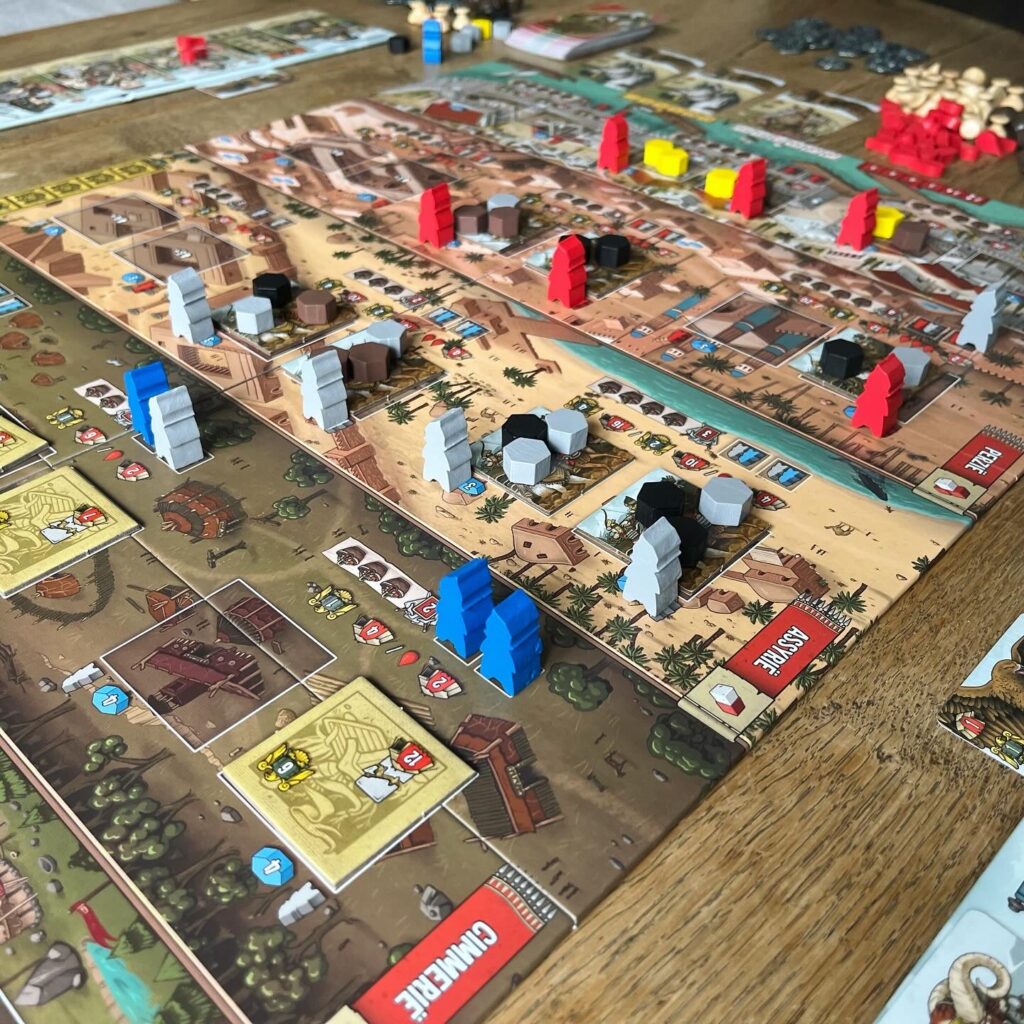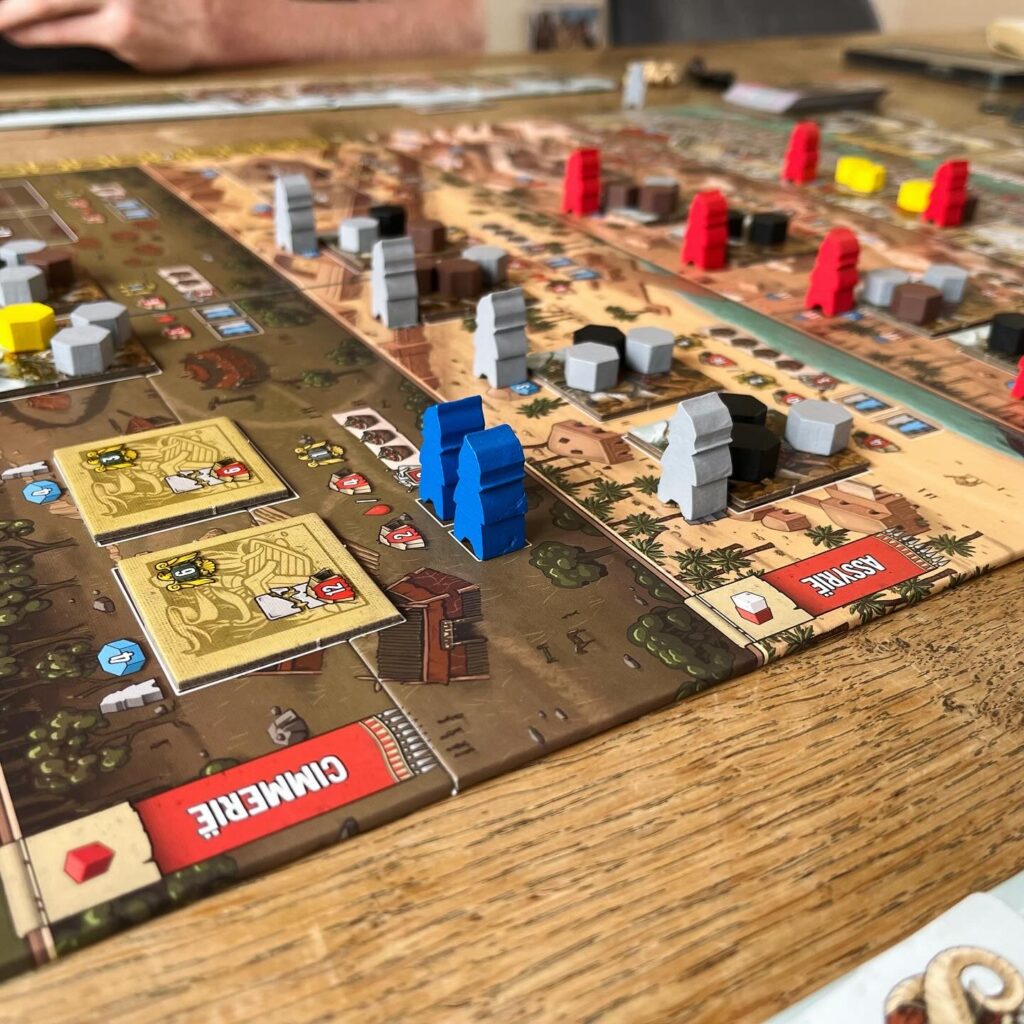These horsemen are the terror of the steppes and are feared from Cimmeria to Assyria and from Persia to Greece. Their ruthless raids and unsurpassed skills on horseback are notorious: the Raiders of Scythia.
Background and goal
Raiders of the North Sea is a popular Garphill Games title. Raiders had a unique twist in which players placed a worker and then “left” this worker at the location, received a new worker for this and could possibly even perform an additional action.
The original Raiders game is part of Garphill Games’ signature historical game series which includes the other … of the North Sea, … of the Western Kingdom and … of the Southern Tigris (at least for now). All of these games feature artwork by The Mico, similar (obvious) symbolism and thematic gameplay. All of these games offer a unique twist on game mechanics.

In addition to this historical series, Garphill also releases other games with a thematic historical, but somewhat more legendary, jacket. Think of Legacy of Yu, Hadrian’s Wall and also Raiders of Scythia. All of these games “share” Sam Philips’ colorful and distinctive artwork. Rovers of Scythia is the first of these games and basically shares the same mechanics with Raiders of the North Sea. So it is a so-called reworking, but enough variety to easily stand on its own. The game includes some different actions, now includes animal cards to assist your warriors, a hero with extra abilities and an asymmetrical sauce and other game-end condition.
The Vikings of the North Sea are traded with the horsemen of the legendary Scythians: a group of peoples and cultures from modern-day Iran who traveled on their horses across the Eurasian steppe to go on raids in Cimmeria, Assyria, Persia and Greece, among other places.
After players set up the game (see below), they are ready to go on a rampage. Like Raiders of the North Sea, Raiders of Scythia is a worker placement game with a twist. Players place their workers to take actions, stockpile supplies and loot for loot. With loot, players can go on more “interesting” raids and/or complete missions. With missions and raids, players earn points. If a number of missions are completed or loot trips are performed, looting comes to an end and the player with the most points wins.
Setup
Players place the game board in the center of the table. In different places, depending on the number of players, players place different mission tiles. Some tiles are placed open and some are placed face down on the game board. Loot is randomly placed on the indicated spaces (for convenience, the game includes a draw bag). The amount of loot varies by field and the draw sat includes gold, equipment, wagons and livestock. In addition to loot, workers are also placed next to the fields as indicated on the board.


Next to the game board, players create a general supply with the various supplies (provisions and kumis), coins, wounds and cards. Next to the board comes a market with animal cards and draw pile with the warriors.
Each player is given a board where they can place their hero, warriors and animals during the game. Players start the game with a hero and a warrior that they get to place on their player board in advance and also a handful of warriors that they can hire during the game to go on raids.
Gameplay
Each turn, a player places a worker and takes back a worker. There are three different types of workers and some fields may only be entered by a worker of the correct color, or the action to be performed varies by color.
When players do actions in the village at the top of the board, they place a worker in an empty field to perform an action, then they take a worker from a previously occupied field and perform that action as well. Two actions for the price of 1! These actions allow players to hire warriors (place cards on their personal board) by paying coins, collect provisions or kumis, perform actions from cards or animals, draw new cards and complete missions.


When players perform actions outside the village they go looting. They place their worker at the relevant loot fields, deposit the necessary provisions, loot, etc. They can plunder only if they have enough crew. They roll the die to determine their attack value, deposit any koemis to do so to shed their strength and see how much strength their warriors have. Depending on the result, combatants may receive wounds (they may even die) and players hopefully get points (and the loot)! Next, take the the warrior that was placed here at the beginning of the game.
Verdict
The mechanics of Raiders (both variants) remain ironclad. The twist where players place a worker and have to take one back offers an awful lot of surprising combinations of actions and tactics. Players also slowly gain access to different colors of workers during the game, unlocking several new abilities.
The game has a tight and clear gameplay and is fun to play with all the indicated player numbers, as it adapts well to the amount of players. Because of the different types of warriors, heroes, mission tiles and because loot is moved randomly, the game is also very varied and lends itself to multiple types of play styles. The colorful artwork and clear symbolism make for a thematic experience and intuitive gameplay. All this together makes Raiders highly recommended for fans of tactical and strategic games.






